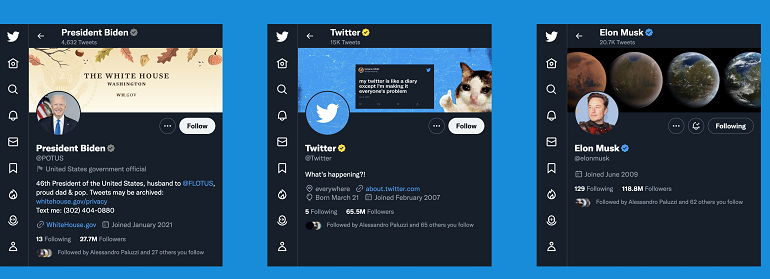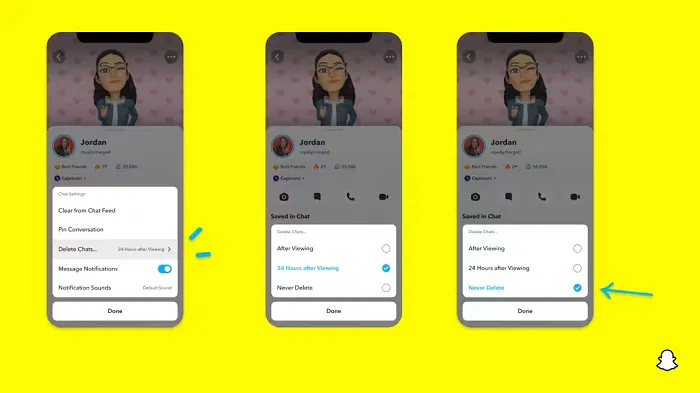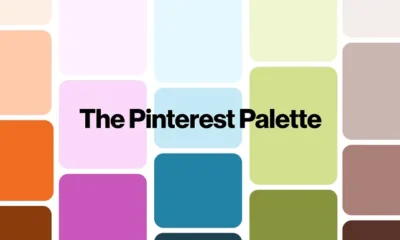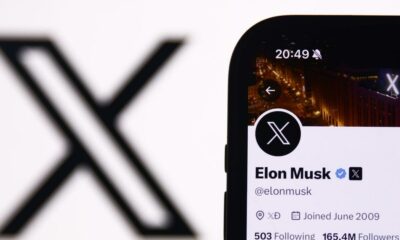SOCIAL
Elon Musk Outlines New, Alternate Color Checkmarks to Clarify Verification

Elon Musk has revealed more details of the coming revamp of Twitter’s $8 verification program, which was initially launched three weeks back, but then pulled from live production due to a raft of impersonations which caused significant confusion in the app.
Those impersonations also led to stock price dips, corporate apologies, misreporting – the $8 verification plan, while only available to some users, for a short amount of time, immediately caused significant issues for Twitter and it’s as partners.
So Elon and Co. took it back, in order to revise and re-shape the program in a more brand-safe, user-friendly way.
And now, Musk has revealed more details as to exactly how the updated $8 verification plan will work.
First, to limit the potential of misrepresentation of corporate and government accounts, Musk says that those profiles will now get a different colored checkmark, which will ensure that people can’t just buy a blue tick and then pretend to be Coca-Cola for example.
As per Musk:
“Gold check for companies, gray check for government, blue for individuals (celebrity or not)”
App researcher Alessandro Paluzzi posted these examples of how these new ticks might look in the app.
It’s a sensible move, which will avoid similar incidents like this tweet from an $8 verified account, which tanked Eli Lilly’s stock price.

The updated gold checkmark will ideally limit the potential for future users to do the same, because they won’t be able to buy the official gold tick – though there will be a period of adjustment and education on such for users.
The alternate checkmarks will also likely kill off Twitter’s new gray ‘Official’ tick, which looks pretty ridiculous.

Of course, the new variations of checkmarks do also add the potential problem of another elusive marker that people will be trying to get. But we’ll cross that extra complication when we come to it.
Another concern with this approach is that it’ll require manual checking, as Twitter can’t know for sure that it’s a brand or government account without some kind of confirmation.
Initially, Twitter has thus far opted to avoid any kind of manual confirmation in this new process, due to the additional labor requirement, but now, Musk says that this will be integrated into the updated process:
“All verified accounts will be manually authenticated before check activates. Painful, but necessary.”
How Musk and Co. do that with any level of efficiency, with 65% less staff, I don’t know, but it seems like they’re going to at least try to find a way to check each $8 subscriber before approving their blue tick.
Musk also noted last week that any change in user name will result in a blue tick being deactivated till Twitter approves the new name.
So, like, a lot of manual monitoring, with a lot less staff.
Also, for the traditional blue checkmarks, there’ll be no differentiation between those who’ve been given the marker, and those who’ve paid for it:
“All verified individual humans will have same blue check, as boundary of what constitutes ‘notable’ is otherwise too subjective.”
Which is true – there are a lot of blue checkmarks on random accounts, and it has been a confused system. But at the same time, there are also a lot of high-profile individuals who could be at risk of impersonation under this system – which, incidentally, is why the blue ticks were introduced in the first place (in 2009, an MLB star sued Twitter for allowing a scammer to use his likeness to dupe people in the app).
There’s also this:
“Individuals can have secondary tiny logo showing they belong to an org if verified as such by that org.”
So an additional qualifier for spokespeople, CEOs and journalists, as another measure to avoid impersonation.
The updated elements will certainly lessen the scope for scam activity, but still, they do also introduce a level of risk, and at the same time, the scheme itself is unlikely to work out as Musk hopes.
The revamp of Twitter’s verification program is Elon’s first grand plan to save the app (aside from cutting costs), by giving users access to one of the most in-demand in-app features – the elusive blue checkmark.
Charging for verification could theoretically kill two birds with one stone, in verifying real humans (while making it cost-prohibitive to crate bot accounts) while also providing a direct revenue stream, thereby reducing the company’s reliance in ads. People want the blue tick, now they can get it, while Musk has also sought to amplify the cultural divide element, by presenting this as a way to even the field, and enable all users to get what only celebrities have thus far been able to access.
Initially, Musk was set to charge $20 per month for this service, but after an argument with the author of ‘Misery’, he reduced this to $8 per month.
In Musk’s view, this is a good deal, because who doesn’t have an extra $8 to spend?
He’s since sought to establish this as the norm, repeatedly telling his critics to ‘now pay $8’, as if it’s a forgone conclusion that people will indeed pay.
But they won’t, and history shows that there’s almost no chance that Musk’s paid verification scheme will actually work as intended.
Take, for example, Twitter Blue, which provides Twitter users with a raft of additional features, which was initially available for $3 per month.
Twitter Blue never saw much take-up, peaking at 100k subscribers, with even the addition of tweet editing, the most requested feature in social media history, failing to shift the needle in any significant way.
Given this, it’s difficult to see Musk’s new, $8 verification getting the number of sign ups he’d need to achieve his aims for the option.
For context:
- If Elon wants to get subscriptions to contribute 50% of Twitter’s revenue, as he’s previously stated, he’ll need 24.6 million users to sign on to pay $8 per month for a blue tick
- If he wants to use this as a means to verify all the humans, so that only bot accounts are the ones that don’t have a blue tick, you’d think he’d be looking at upwards of 75% of Twitter’s user base, or around 178 million users paying each month
- Twitter’s likely to actually lose around $6 per US user, per month, for each person that signs up to the new $8 Twitter Blue scheme, due to Musk’s plan to show Blue subscribers ‘half the ads’. Factoring in App Store fees from the monthly $8 payment, it could actually be a difficult balance from a revenue standpoint, with Twitter potentially even losing money on the deal, if it does end up cutting ad exposure
- The majority of Twitter users are outside the US, where $8 per month could be a lot more cost-prohibitive. This is especially true in India, where most of Twitter’s growth has come from over the past three years. India now has 18.8m users making it Twitter’s third biggest audience market, and while Musk has also flagged variable pricing by region, even $1 per month could be too high for developing markets
Essentially, there’s no precedent to suggest that enough users will sign up to Elon’s $8 per month checkmark plan to make it worthwhile for the company to run, as either a revenue or verification pathway. Just 0.41% of Snapchat users pay for Snapchat+, a fraction of LinkedIn users pony up for Premium, while Meta concluded long ago that charging users was no where near as lucrative as serving a bigger audience more ads.
These new measures do counter some of the issues that the initial version of Musk’s $8 verification program introduced, but then again, they could also avoid them entirely by revising the current blue check system, as opposed to simply letting people pay for the marker.
But regardless, Musk is determined to push ahead, and find out for himself either way
Musk says the updated $8 verification plan will launch on Friday next week (12/2).
SOCIAL
12 Proven Methods to Make Money Blogging in 2024

 This is a contributed article.
This is a contributed article.
The world of blogging continues to thrive in 2024, offering a compelling avenue for creative minds to share their knowledge, build an audience, and even turn their passion into profit. Whether you’re a seasoned blogger or just starting, there are numerous effective strategies to monetize your blog and achieve financial success. Here, we delve into 12 proven methods to make money blogging in 2024:
1. Embrace Niche Expertise:
Standing out in the vast blogosphere requires focus. Carving a niche allows you to cater to a specific audience with targeted content. This not only builds a loyal following but also positions you as an authority in your chosen field. Whether it’s gardening techniques, travel hacking tips, or the intricacies of cryptocurrency, delve deep into a subject you’re passionate and knowledgeable about. Targeted audiences are more receptive to monetization efforts, making them ideal for success.
2. Content is King (and Queen):
High-quality content remains the cornerstone of any successful blog. In 2024, readers crave informative, engaging, and well-written content that solves their problems, answers their questions, or entertains them. Invest time in crafting valuable blog posts, articles, or videos that resonate with your target audience.
- Focus on evergreen content: Create content that remains relevant for a long time, attracting consistent traffic and boosting your earning potential.
- Incorporate multimedia: Spice up your content with captivating images, infographics, or even videos to enhance reader engagement and improve SEO.
- Maintain consistency: Develop a regular publishing schedule to build anticipation and keep your audience coming back for more.
3. The Power of SEO:
Search Engine Optimization (SEO) ensures your blog ranks high in search engine results for relevant keywords. This increases organic traffic, the lifeblood of any monetization strategy.
- Keyword research: Use keyword research tools to identify terms your target audience searches for. Strategically incorporate these keywords into your content naturally.
- Technical SEO: Optimize your blog’s loading speed, mobile responsiveness, and overall technical aspects to improve search engine ranking.
- Backlink building: Encourage other websites to link back to your content, boosting your blog’s authority in the eyes of search engines.
4. Monetization Magic: Affiliate Marketing
Affiliate marketing allows you to earn commissions by promoting other companies’ products or services. When a reader clicks on your affiliate link and makes a purchase, you get a commission.
- Choose relevant affiliates: Promote products or services that align with your niche and resonate with your audience.
- Transparency is key: Disclose your affiliate relationships clearly to your readers and build trust.
- Integrate strategically: Don’t just bombard readers with links. Weave affiliate promotions naturally into your content, highlighting the value proposition.
5. Display Advertising: A Classic Approach
Display advertising involves placing banner ads, text ads, or other visual elements on your blog. When a reader clicks on an ad, you earn revenue.
- Choose reputable ad networks: Partner with established ad networks that offer competitive rates and relevant ads for your audience.
- Strategic ad placement: Place ads thoughtfully, avoiding an overwhelming experience for readers.
- Track your performance: Monitor ad clicks and conversions to measure the effectiveness of your ad placements and optimize for better results.
6. Offer Premium Content:
Providing exclusive, in-depth content behind a paywall can generate additional income. This could be premium blog posts, ebooks, online courses, or webinars.
- Deliver exceptional value: Ensure your premium content offers significant value that justifies the price tag.
- Multiple pricing options: Consider offering tiered subscription plans to cater to different audience needs and budgets.
- Promote effectively: Highlight the benefits of your premium content and encourage readers to subscribe.
7. Coaching and Consulting:
Leverage your expertise by offering coaching or consulting services related to your niche. Readers who find your content valuable may be interested in personalized guidance.
- Position yourself as an expert: Showcase your qualifications, experience, and client testimonials to build trust and establish your credibility.
- Offer free consultations: Provide a limited free consultation to potential clients, allowing them to experience your expertise firsthand.
- Develop clear packages: Outline different coaching or consulting packages with varying time commitments and pricing structures.
8. The Power of Community: Online Events and Webinars
Host online events or webinars related to your niche. These events offer valuable content while also providing an opportunity to promote other monetization avenues.
- Interactive and engaging: Structure your online events to be interactive with polls, Q&A sessions, or live chats. Click here to learn more about image marketing with Q&A sessions and live chats.
9. Embrace the Power of Email Marketing:
Building an email list allows you to foster stronger relationships with your audience and promote your content and offerings directly.
- Offer valuable incentives: Encourage readers to subscribe by offering exclusive content, discounts, or early access to new products.
- Segmentation is key: Segment your email list based on reader interests to send targeted campaigns that resonate more effectively.
- Regular communication: Maintain consistent communication with your subscribers through engaging newsletters or updates.
10. Sell Your Own Products:
Take your expertise to the next level by creating and selling your own products. This could be physical merchandise, digital downloads, or even printables related to your niche.
- Identify audience needs: Develop products that address the specific needs and desires of your target audience.
- High-quality offerings: Invest in creating high-quality products that offer exceptional value and user experience.
- Utilize multiple platforms: Sell your products through your blog, online marketplaces, or even social media platforms.
11. Sponsorships and Brand Collaborations:
Partner with brands or businesses relevant to your niche for sponsored content or collaborations. This can be a lucrative way to leverage your audience and generate income.
- Maintain editorial control: While working with sponsors, ensure you retain editorial control to maintain your blog’s authenticity and audience trust.
- Disclosures are essential: Clearly disclose sponsored content to readers, upholding transparency and ethical practices.
- Align with your niche: Partner with brands that complement your content and resonate with your audience.
12. Freelancing and Paid Writing Opportunities:
Your blog can serve as a springboard for freelance writing opportunities. Showcase your writing skills and expertise through your blog content, attracting potential clients.
- Target relevant publications: Identify online publications, websites, or magazines related to your niche and pitch your writing services.
- High-quality samples: Include high-quality blog posts from your site as writing samples when pitching to potential clients.
- Develop strong writing skills: Continuously hone your writing skills and stay updated on current trends in your niche to deliver exceptional work.
Conclusion:
Building a successful blog that generates income requires dedication, strategic planning, and high-quality content. In today’s digital age, there are numerous opportunities to make money online through blogging. By utilizing a combination of methods such as affiliate marketing, sponsored content, and selling digital products or services, you can leverage your blog’s potential and achieve financial success.
Remember, consistency in posting, engaging with your audience, and staying adaptable to trends are key to thriving in the ever-evolving blogosphere. Embrace new strategies, refine your approaches, and always keep your readers at the forefront of your content creation journey. With dedication and the right approach, your blog has the potential to become a valuable source of income and a platform for sharing your knowledge and passion with the world, making money online while doing what you love.
Image Credit: DepositPhotos
SOCIAL
Snapchat Explores New Messaging Retention Feature: A Game-Changer or Risky Move?

In a recent announcement, Snapchat revealed a groundbreaking update that challenges its traditional design ethos. The platform is experimenting with an option that allows users to defy the 24-hour auto-delete rule, a feature synonymous with Snapchat’s ephemeral messaging model.
The proposed change aims to introduce a “Never delete” option in messaging retention settings, aligning Snapchat more closely with conventional messaging apps. While this move may blur Snapchat’s distinctive selling point, Snap appears convinced of its necessity.
According to Snap, the decision stems from user feedback and a commitment to innovation based on user needs. The company aims to provide greater flexibility and control over conversations, catering to the preferences of its community.
Currently undergoing trials in select markets, the new feature empowers users to adjust retention settings on a conversation-by-conversation basis. Flexibility remains paramount, with participants able to modify settings within chats and receive in-chat notifications to ensure transparency.
Snapchat underscores that the default auto-delete feature will persist, reinforcing its design philosophy centered on ephemerality. However, with the app gaining traction as a primary messaging platform, the option offers users a means to preserve longer chat histories.
The update marks a pivotal moment for Snapchat, renowned for its disappearing message premise, especially popular among younger demographics. Retaining this focus has been pivotal to Snapchat’s identity, but the shift suggests a broader strategy aimed at diversifying its user base.
This strategy may appeal particularly to older demographics, potentially extending Snapchat’s relevance as users age. By emulating features of conventional messaging platforms, Snapchat seeks to enhance its appeal and broaden its reach.
Yet, the introduction of message retention poses questions about Snapchat’s uniqueness. While addressing user demands, the risk of diluting Snapchat’s distinctiveness looms large.
As Snapchat ventures into uncharted territory, the outcome of this experiment remains uncertain. Will message retention propel Snapchat to new heights, or will it compromise the platform’s uniqueness?
Only time will tell.
SOCIAL
Catering to specific audience boosts your business, says accountant turned coach

While it is tempting to try to appeal to a broad audience, the founder of alcohol-free coaching service Just the Tonic, Sandra Parker, believes the best thing you can do for your business is focus on your niche. Here’s how she did just that.
When running a business, reaching out to as many clients as possible can be tempting. But it also risks making your marketing “too generic,” warns Sandra Parker, the founder of Just The Tonic Coaching.
“From the very start of my business, I knew exactly who I could help and who I couldn’t,” Parker told My Biggest Lessons.
Parker struggled with alcohol dependence as a young professional. Today, her business targets high-achieving individuals who face challenges similar to those she had early in her career.
“I understand their frustrations, I understand their fears, and I understand their coping mechanisms and the stories they’re telling themselves,” Parker said. “Because of that, I’m able to market very effectively, to speak in a language that they understand, and am able to reach them.”Â
“I believe that it’s really important that you know exactly who your customer or your client is, and you target them, and you resist the temptation to make your marketing too generic to try and reach everyone,” she explained.
“If you speak specifically to your target clients, you will reach them, and I believe that’s the way that you’re going to be more successful.
Watch the video for more of Sandra Parker’s biggest lessons.














You must be logged in to post a comment Login